初中英语常用复数形式的名词
- 格式:doc
- 大小:42.50 KB
- 文档页数:7

【初中英语】初中英语知识点:可数名词(单数名词,复数名词)可数名词:它指的是可以用数字计算并划分为个体的人或事物;因此它有复数形式,当它的复数形式在句子中作主语时,句子的谓语也应用复数形式。
将名词单数改为复数的规则:情况合成法例词发音一般情况在单词末尾加-sdesk→desks地图→地图-s在清辅音后发/s/白天→天girl→girls-元音和浊音辅音后的S/Z/以s,x,ch,sh结尾的词在单词末尾加-esbus→busesbox→boxeswatch→watchesfish→fishes-ES/iz/声音以辅音字母加-y结尾的词将y改为I plus-esfamily→families工厂→工厂party→patries-Ies/iz/声音以元音字母加-y结尾的词在单词末尾加-sday→days男孩→男孩们key→keys-S/Z/声音以f或fe结尾的词F或ES变成-Vknife→knives生活→生活wife→wives一半→一半-ves发/vz/音以辅音加-O结尾的单词在词尾加-es马铃薯→土豆tomato→tomatoes英雄→英雄-es发/z/音以元音加-O结尾的单词在词尾加-s无线电广播→收音机zoo→zoos-S/Z/声音巧记以f\fe结尾的可数名词复数妻子骑着牛,拿起刀,妻子,小牛,刀↑追得贼狼满街跑,thief,wolf→→→变f或fe为v,再加es 自我,生活↓手帕树叶半空飘。
handkerchief,leaf,half↓名词复数的不规则变化:1.不规则形式:儿童→ 儿童man→men(男人)成年女子→ 成年女子anenglishman→twoenglishmen(英国人)脚→ 脚tooth→teeth(牙)老鼠→ 老鼠ox→oxen(公牛)鹅→ 鹅2.单复同形:鹿、羊、鱼、中国人、日本人、物种、手段、瑞士人除人民币,美元、英镑、法郎等都有复数形式。
比如:阿道拉,两个多拉;阿米特,两米3.集体名词,以单数形式出现,但实为复数:人是复数(ok:aperson,apoliceman,aheadofcattle,theenglish,thebritish,thefrench,thechinese,thejapanese,theswiss)(错误:apeople、apolice、acattle)表示国民总称时,作复数用。
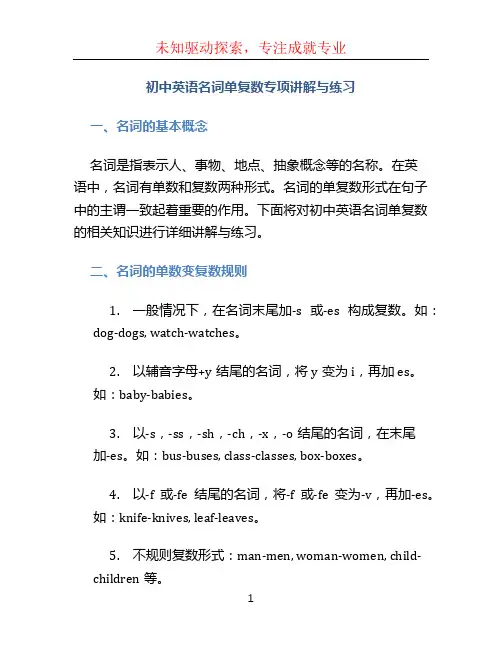
初中英语名词单复数专项讲解与练习一、名词的基本概念名词是指表示人、事物、地点、抽象概念等的名称。
在英语中,名词有单数和复数两种形式。
名词的单复数形式在句子中的主谓一致起着重要的作用。
下面将对初中英语名词单复数的相关知识进行详细讲解与练习。
二、名词的单数变复数规则1.一般情况下,在名词末尾加-s或-es构成复数。
如:dog-dogs, watch-watches。
2.以辅音字母+y结尾的名词,将y变为i,再加es。
如:baby-babies。
3.以-s,-ss,-sh,-ch,-x,-o结尾的名词,在末尾加-es。
如:bus-buses, class-classes, box-boxes。
4.以-f或-fe结尾的名词,将-f或-fe变为-v,再加-es。
如:knife-knives, leaf-leaves。
5.不规则复数形式:man-men, woman-women, child-children等。
三、名词单复数变化的使用在句子中,名词的单复数形式需要与其他语法要素保持一致,主要包括动词、形容词和冠词。
下面是一些常见的用法:1.主语与谓语动词一致:The boys play football.(男孩们踢足球。
)2.冠词的使用:He has a book. She has two books.(他有一本书。
她有两本书。
)3.形容词的使用:I have a black cat. We have twoblack cats.(我有一只黑猫。
我们有两只黑猫。
)四、练习题1.将下列单数名词变为复数形式:–cat–pencil–watch–tomato–bus2.将下列单数名词变为复数形式,并构造一个句子:–tooth–child–box–leaf–knife五、答案1.将下列单数名词变为复数形式:–cat - cats–pencil - pencils–watch - watches–tomato - tomatoes–bus - buses2.将下列单数名词变为复数形式,并构造一个句子:–tooth - teeth. She has two teeth.(她有两颗牙齿。
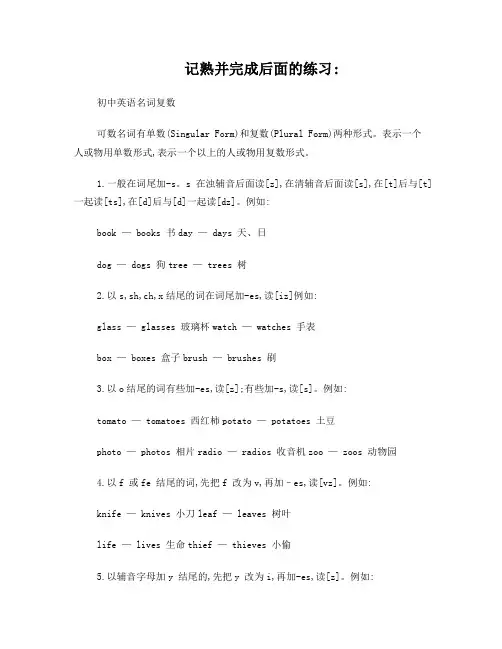
记熟并完成后面的练习:初中英语名词复数可数名词有单数(Singular Form)和复数(Plural Form)两种形式。
表示一个人或物用单数形式,表示一个以上的人或物用复数形式。
1.一般在词尾加-s。
s在浊辅音后面读[z],在清辅音后面读[s],在[t]后与[t]一起读[ts],在[d]后与[d]一起读[dz]。
例如:book — books 书day — days 天、日dog — dogs 狗tree — trees 树2.以s,sh,ch,x结尾的词在词尾加-es,读[iz]例如:glass — glasses 玻璃杯watch — watches 手表box — boxes 盒子brush — brushes 刷3.以o结尾的词有些加-es,读[z];有些加-s,读[s]。
例如:tomato — tomatoes 西红柿potato — potatoes 土豆photo — photos 相片radio — radios 收音机zoo — zoos 动物园4.以f 或fe 结尾的词,先把f 改为v,再加–es,读[vz]。
例如:knife — knives 小刀leaf — leaves 树叶life — lives 生命thief — thieves 小偷5.以辅音字母加y 结尾的,先把y 改为i,再加-es,读[z]。
例如:story — stories 故事city — cities 城市family — families 家庭baby — babies 婴儿注意:boy — boys 男孩toy — toys 玩具key — keys 钥匙6.有些名词有不规则的复数形式。
例如:man — men 男人woman — women 妇女tooth — teeth 牙齿foot — feet 脚7.有些名词的单复数形式相同。
例如;deer — deer 鹿sheep — sheep绵羊Chinese — Chinese 中国人Japanese — Japanese 日本人8.有些学科名词虽以s 结尾,但通常都做单数名词看待。
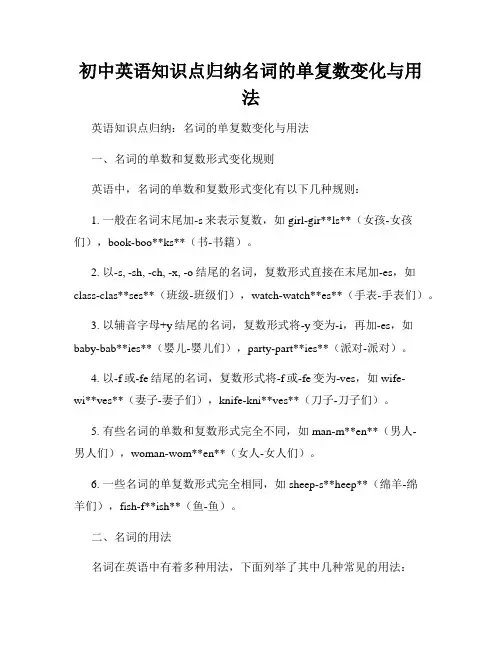
初中英语知识点归纳名词的单复数变化与用法英语知识点归纳:名词的单复数变化与用法一、名词的单数和复数形式变化规则英语中,名词的单数和复数形式变化有以下几种规则:1. 一般在名词末尾加-s来表示复数,如girl-gir**ls**(女孩-女孩们),book-boo**ks**(书-书籍)。
2. 以-s, -sh, -ch, -x, -o结尾的名词,复数形式直接在末尾加-es,如class-clas**ses**(班级-班级们),watch-watch**es**(手表-手表们)。
3. 以辅音字母+y结尾的名词,复数形式将-y变为-i,再加-es,如baby-bab**ies**(婴儿-婴儿们),party-part**ies**(派对-派对)。
4. 以-f或-fe结尾的名词,复数形式将-f或-fe变为-ves,如wife-wi**ves**(妻子-妻子们),knife-kni**ves**(刀子-刀子们)。
5. 有些名词的单数和复数形式完全不同,如man-m**en**(男人-男人们),woman-wom**en**(女人-女人们)。
6. 一些名词的单复数形式完全相同,如sheep-s**heep**(绵羊-绵羊们),fish-f**ish**(鱼-鱼)。
二、名词的用法名词在英语中有着多种用法,下面列举了其中几种常见的用法:1. 主语:名词可以作为句子的主语,如"**Cats** are my favorite animals."(猫是我最喜欢的动物)。
2. 宾语:名词可以作为句子的宾语,接受动作的影响,如"I love **dogs**."(我喜欢狗)。
3. 定语:名词可以作为另一个名词的定语,用来限定其意义,如"**Book** store"(书店)。
4. 表语:名词可以作为系动词的表语,说明主语的身份、性质等,如"The girl is a **student**."(这个女孩是一名学生)。
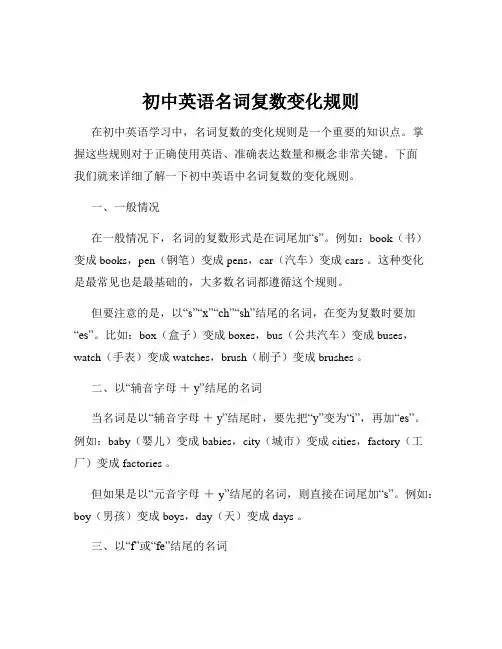
初中英语名词复数变化规则在初中英语学习中,名词复数的变化规则是一个重要的知识点。
掌握这些规则对于正确使用英语、准确表达数量和概念非常关键。
下面我们就来详细了解一下初中英语中名词复数的变化规则。
一、一般情况在一般情况下,名词的复数形式是在词尾加“s”。
例如:book(书)变成 books,pen(钢笔)变成 pens,car(汽车)变成 cars 。
这种变化是最常见也是最基础的,大多数名词都遵循这个规则。
但要注意的是,以“s”“x”“ch”“sh”结尾的名词,在变为复数时要加“es”。
比如:box(盒子)变成 boxes,bus(公共汽车)变成 buses,watch(手表)变成 watches,brush(刷子)变成 brushes 。
二、以“辅音字母+y”结尾的名词当名词是以“辅音字母+y”结尾时,要先把“y”变为“i”,再加“es”。
例如:baby(婴儿)变成 babies,city(城市)变成 cities,factory(工厂)变成 factories 。
但如果是以“元音字母+ y”结尾的名词,则直接在词尾加“s”。
例如:boy(男孩)变成 boys,day(天)变成 days 。
三、以“f”或“fe”结尾的名词对于以“f”或“fe”结尾的名词,通常要先把“f”或“fe”变为“v”,再加“es”。
比如:leaf(树叶)变成 leaves,knife(小刀)变成 knives,wife (妻子)变成 wives 。
但也有一些例外,直接加“s”即可,如:roof(屋顶)变成 roofs,gulf(海湾)变成 gulfs 。
四、不规则变化有些名词的复数形式属于不规则变化,需要特别记忆。
1、单复数同形例如:sheep(绵羊),deer(鹿),fish(鱼)等,它们的单数和复数形式是一样的。
2、改变元音字母例如:man(男人)变成 men,woman(女人)变成 women,foot (脚)变成 feet,tooth(牙齿)变成 teeth 。
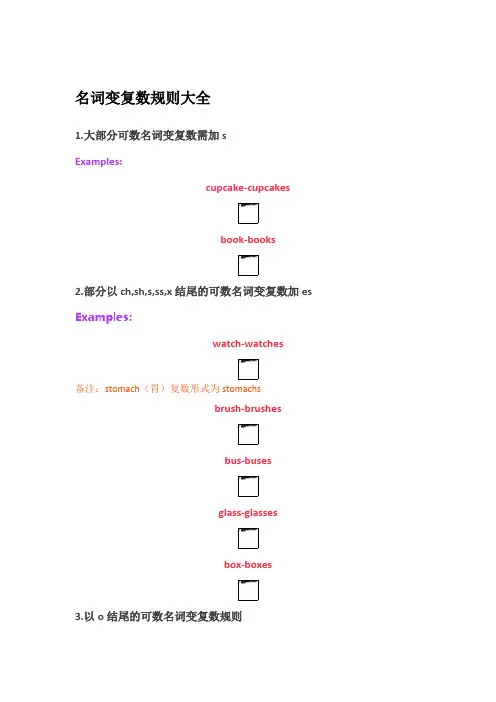
名词变复数规则大全1.大部分可数名词变复数需加sExamples:cupcake-cupcakesbook-books2.部分以ch,sh,s,ss,x结尾的可数名词变复数加es Examples:watch-watches备注:stomach(胃)复数形式为stomachsbrush-brushesbus-busesglass-glassesbox-boxes3.以o结尾的可数名词变复数规则1.大部分以o结尾的可数名词变复数直接加sExamples:autos(汽车) kilos(公斤) memos(备忘录) photos(相片) pianos(钢琴) radios(收音机) solos(独奏) sopranos(女高音) studios(工作室) tattoos(纹身) videos(视频) zoos(动物园)2.部分以o结尾的可数名词变复数加esExamples:heroes(英雄) tomatoes(西红柿) potatoes(土豆) echoes(回声) Negroes(黑人) torpedoes(鱼雷) vetoes(否决) embargoes(禁令)3.部分以o结尾的可数名词变复数可以加s或esExamples:mangos/mangoes(芒果)mosquito/mosquitoes(蚊子)volcanos/volcanoes(火山)zeros/zeroes(零)buffalos/buffaloes(水牛)4.以y结尾的可数名词变复数规则1.y之前字母是a,e,i,o,u的话,此名词变复数直接加s Examples:boys(男孩) keys(钥匙) days(天)2.y之是其他字母,此名词变复数要变y为i并加es Examples:baby-babies(婴儿) city-cities(城市)country-countries(国家)5.以f、fe结尾可数名词变复数规则1.大多数以f或fe结尾的可数名词变复数需要将f或fe变为v并加es Examples:calf-calves(小牛) half-halves(一半)thief-thieves(小偷) wife-wives(妻子)life-lives(生命) shelf-shelves(架子)knife-knives(刀) leaf-leaves(叶子)self-seves(自我) wolf-wolves(狼)2.部分以f或fe结尾的可数名词变复数加sExamples:chief-chiefs(首领) roof-roofs(房顶)。
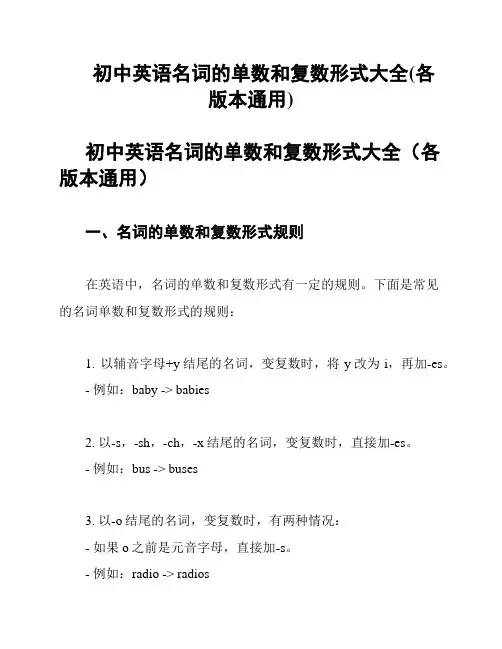
初中英语名词的单数和复数形式大全(各版本通用)初中英语名词的单数和复数形式大全(各版本通用)一、名词的单数和复数形式规则在英语中,名词的单数和复数形式有一定的规则。
下面是常见的名词单数和复数形式的规则:1. 以辅音字母+y结尾的名词,变复数时,将y改为i,再加-es。
- 例如:baby -> babies2. 以-s,-sh,-ch,-x结尾的名词,变复数时,直接加-es。
- 例如:bus -> buses3. 以-o结尾的名词,变复数时,有两种情况:- 如果o之前是元音字母,直接加-s。
- 例如:radio -> radios- 如果o之前是辅音字母,加-es。
- 例如:potato -> potatoes4. 以-f或-fe结尾的名词,变复数时,将f或fe改为v,再加-es。
- 例如:leaf -> leaves5. 一些不规则名词的复数形式:- 例如:child -> children二、常见名词的单数和复数形式下面是一些常见名词的单数和复数形式的示例:- cat(猫): cats(复数)- dog(狗): dogs(复数)- book(书): books(复数)- table(桌子): tables(复数)- student(学生): students(复数)- teacher(老师): teachers(复数)- city(城市): cities(复数)- country(国家): countries(复数)请注意,以上仅列举了一部分常见名词的单数和复数形式,还有更多名词的单数和复数形式需要根据具体情况进行研究和记忆。
三、注意事项在研究名词的单数和复数形式时,需要注意以下几点:1. 有些名词的复数形式与其单数形式完全相同。
- 例如:sheep(羊):sheep(复数)2. 有些名词只有复数形式,没有单数形式。
- 例如:scissors(剪刀):scissors3. 有些名词既可以作单数,又可以作复数,意思可能有所不同。
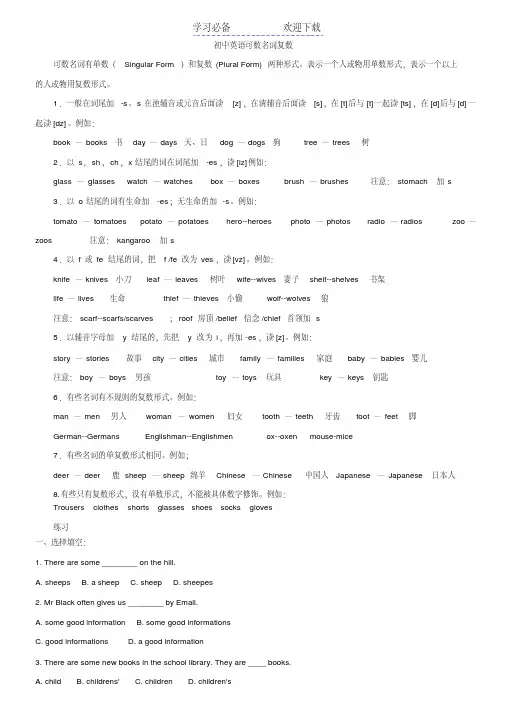
初中英语可数名词复数可数名词有单数(Singular Form)和复数(Plural Form)两种形式。
表示一个人或物用单数形式,表示一个以上的人或物用复数形式。
1.一般在词尾加-s。
s在浊辅音或元音后面读[z],在清辅音后面读[s],在[t]后与[t]一起读[ts],在[d]后与[d]一起读[dz]。
例如:book — books 书day — days 天、日dog — dogs 狗tree — trees 树2.以s,sh,ch,x结尾的词在词尾加-es,读[iz]例如:glass — glasses watch — watches box — boxes brush — brushes 注意:stomach加s 3.以o结尾的词有生命加-es;无生命的加-s。
例如:tomato — tomatoes potato — potatoes hero--heroes photo — photos radio — radios zoo —zoos 注意:kangaroo加s4.以 f 或fe 结尾的词,把 f /fe改为ves,读[vz]。
例如:knife — knives 小刀leaf — leaves 树叶wife--wives妻子shelf--shelves 书架life — lives 生命thief — thieves 小偷wolf--wolves 狼注意:scarf--scarfs/scarves;roof房顶/belief信念/chief首领加s5.以辅音字母加y 结尾的,先把y 改为i,再加-es,读[z]。
例如:story — stories 故事city — cities 城市family — families 家庭baby — babies 婴儿注意:boy — boys 男孩toy — toys 玩具key — keys 钥匙6.有些名词有不规则的复数形式。
例如:man — men 男人woman — women 妇女tooth — teeth 牙齿foot — feet 脚German--Germans Englishman--Englishmen ox--oxen mouse-mice7.有些名词的单复数形式相同。
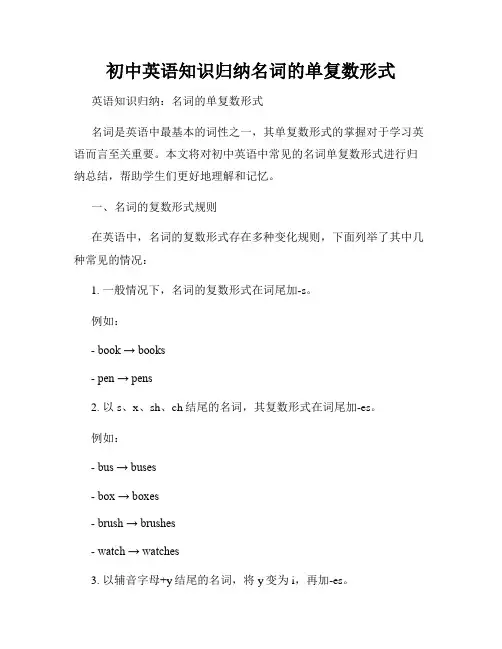
初中英语知识归纳名词的单复数形式英语知识归纳:名词的单复数形式名词是英语中最基本的词性之一,其单复数形式的掌握对于学习英语而言至关重要。
本文将对初中英语中常见的名词单复数形式进行归纳总结,帮助学生们更好地理解和记忆。
一、名词的复数形式规则在英语中,名词的复数形式存在多种变化规则,下面列举了其中几种常见的情况:1. 一般情况下,名词的复数形式在词尾加-s。
例如:- book → books- pen → pens2. 以s、x、sh、ch结尾的名词,其复数形式在词尾加-es。
例如:- bus → buses- box → boxes- brush → brushes- watch → watches3. 以辅音字母+y结尾的名词,将y变为i,再加-es。
例如:- baby → babies- family → families- city → cities4. 以-o结尾的名词,有些在词尾加-es,而另一些只加-s。
例如:- tomato → tomatoes- photo → photos- hero → heroes5. 以-f或-fe结尾的名词,将f或fe变为v,再加-es。
例如:- leaf → leaves- wolf → wolves- wife → wives6. 一些名词的复数形式无规则可循,需通过记忆掌握。
例如:- man → men- woman → women- child → children- tooth → teeth二、名词的单复数形式使用注意事项1. 有些名词既可用作可数名词,也可用作不可数名词。
在表达单个的某种东西时,使用单数形式;而在表达一定数量或泛指时,使用复数形式。
例如:- I bought a book yesterday. (单数形式)- I have many books. (复数形式)2. 有些名词只有复数形式,表示一类事物或一群人/物。
例如:- clothes (衣服)- glasses (眼镜)- scissors (剪刀)3. 有些名词具有相同的单复数形式,即单复数形式相同。
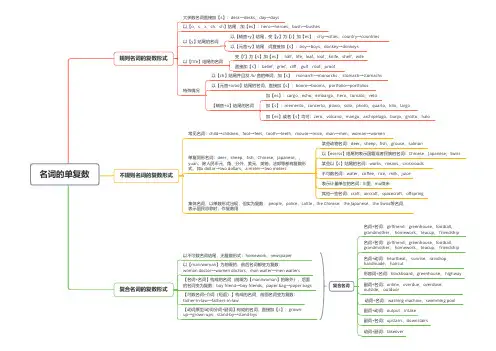
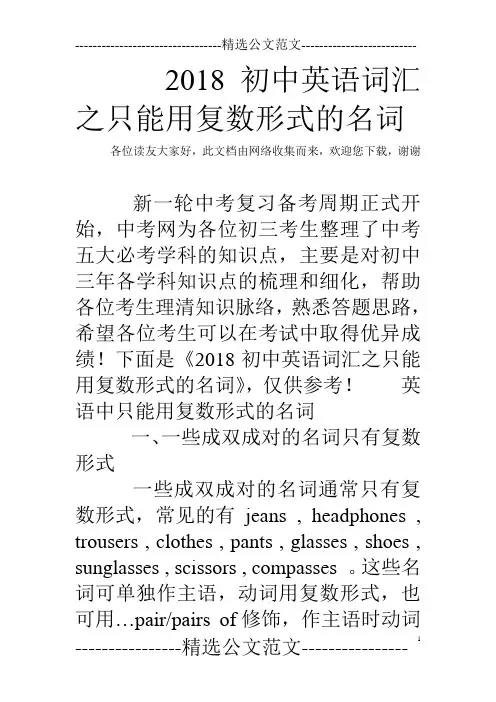
2018初中英语词汇之只能用复数形式的名词各位读友大家好,此文档由网络收集而来,欢迎您下载,谢谢新一轮中考复习备考周期正式开始,中考网为各位初三考生整理了中考五大必考学科的知识点,主要是对初中三年各学科知识点的梳理和细化,帮助各位考生理清知识脉络,熟悉答题思路,希望各位考生可以在考试中取得优异成绩!下面是《2018初中英语词汇之只能用复数形式的名词》,仅供参考!英语中只能用复数形式的名词一、一些成双成对的名词只有复数形式一些成双成对的名词通常只有复数形式,常见的有jeans , headphones , trousers , clothes , pants , glasses , shoes , sunglasses , scissors , compasses 。
这些名词可单独作主语,动词用复数形式,也可用…pair/pairs of修饰,作主语时动词取决于pair的形式。
二、一些食物名词只有复数形式一些食物名词只有复数形式,常见的有noodles, vegetables, snacks。
We will have noodles for supper this evening. 今天晚上我们吃面条。
She likes to eat snacks very much. 她很喜欢吃零食。
三、一些固定短语中的名词只有复数形式一些固定短语中的名词只有复数形式,常见有的express one’s thanks to sb. , a letter of thanks , in high/low spirits , have sports 。
Look, all of them are in high spirits. 瞧,他们的情绪都很高涨。
四、一些不可数名词只有复数形式一些不可数名词只有复数形式,但却表示单数概念,常见的有news , means 。
As we all know, no news is good news. 众所周知,没有消息就是好消息。
初中英语语法汇总:名词单复数形式的总结名词的单复数形式是英语语法中的重要部分。
初中阶段研究名词单复数形式,对于学生打下扎实的语法基础非常重要。
本文总结了初中英语中常见名词的单复数形式规则和一些特殊情况的处理方式。
一、一般名词的单复数形式1. 大多数名词的复数形式,在词尾加-s,如:- book(书)→ books(书籍)- cat(猫)→ cats(猫咪)- dog(狗)→ dogs(狗狗)2. 以s, x, ch, sh结尾的名词,在词尾加-es,如:- bus(公共汽车)→ buses(公共汽车)- box(盒子)→ boxes(盒子)3. 以-o结尾的名词,大多数在词尾加-es,如:- tomato(西红柿)→ tomatoes(西红柿)- potato(土豆)→ potatoes(土豆)但也有少数例外,如:- piano(钢琴)→ pianos(钢琴)4. 以辅音字母+y结尾的名词,变-y为-i,再加-es,如:- baby(婴儿)→ babies(婴儿)5. 以-f或-fe结尾的名词,变-f或-fe为-ves,如:- leaf(叶子)→ leaves(叶子)- knife(刀)→ knives(刀)二、不规则名词的单复数形式除了一般规则外,还有一些名词的单复数形式是不规则的,需要特别注意和记忆。
1. 以-us结尾的名词,复数形式变为-i,如:- cactus(仙人掌)→ cacti(仙人掌)2. 以-is结尾的名词,复数形式变为-es,如:- analysis(分析)→ analyses(分析)3. 以-um结尾的名词,复数形式变为-a,如:- datum(数据)→ data(数据)4. 以-y结尾的名词,去-y加-ies,如:- city(城市)→ cities(城市)5. 一些名词的单复数形式完全不同,需要特别记忆,如:- child(孩子)→ children(孩子们)- man(男人)→ men(男人们)三、名词的特殊用法除了单复数形式,还有一些特殊的名词用法需要留意。
1.名词复数的规则变化变复数后的读音[iz]2.名词复数的不规则变化①单数与复数同形的名词sheep 绵羊 fish 鱼 deer 鹿 Chinese 中国人 Japanese 日本人②词尾加-en或-renox-oxen 牛 child-children 小孩③改变词内元音字母man - men 男人 woman - women 女人 foot - feet 脚 goose - geese 鹅 tooth - teeth 牙齿 mouse-mice 老鼠一. 名词单数变复数填空1.orange text bed cakecomputer apple house quilt plane tree lesson banana shirt month cup parent2.piano photo radio zoo tomato potato hero negro3.class fox watch glass dress brush box bus4.shelf knife wife life leaf thief wolf5.family country army citystory baby butterfly6.toy day key boy7.sheep fish deer Chinese8.child ox man woman foot goose tooth mouse二.代词/ be动词单数变复数this ______ that _________ I _______ you ________she_______ he ________ it ________ am _____ is _______三:把下列的单词变为复数形式1.key2.boy3.family4.case5.backpack6.dictionary7.watchputer 9.game 10.notebook11.bag 12.math 13.alarm 14.video15.tape 16.hat 17.pear 18.egg19.apple 20.carrot 21.vegetable22.star 23.sock 24.shirt 25.shoe26.skirt 27.sweater 28.clerk29.store 30.shop_________四:句子单数变复数1.This is a book. . __________________________2.That is an eraser. ___________________________3.It is a red apple. ____________________________4.I am a boy. ______________________________5.He / She is a teacher. __________________________6.What’s this? _________________________________五:名词复数变单数练习1:Those are my friends._________________________2: They are English boys. __________________________3: They are some erasers. ________________________4: These are dictionaries. ___________________________5: we are students. ___________________________6: what color are your books ? ______________________六:根据句意及所给单词填空。
初中英语知识点归纳名词的单复数形式和单复数形式的用法区别名词的单复数形式和用法区别在英语语法中,名词的单复数形式是一个重要的语法知识点。
掌握名词的单复数形式以及它们在句子中的用法是学好英语的关键之一。
本文将对初中英语中的名词单复数形式和用法区别进行归纳总结,帮助读者更好地掌握这一知识点。
**一、名词的单复数形式**名词的单数指一个人、动物或物体,而名词的复数指多个人、动物或物体。
名词的单复数形式一般通过在词尾添加-s、-es、-ies等来表示。
下面是常见的名词单复数形式的规则:1. 一般情况下,名词在单数形式后面直接加-s来表示复数形式。
例如:book(书)→ books(书籍)、car(汽车)→ cars(汽车)。
2. 以-s、-sh、-ch、-x结尾的名词,在单数形式后面加-es来表示复数形式。
例如:bus(公共汽车)→ buses(公共汽车)、church(教堂)→ churches(教堂)。
3. 以辅音字母+y结尾的名词,将y改为i,再加-es来表示复数形式。
例如:baby(婴儿)→ babies(婴儿们)、party(聚会)→ parties(聚会)。
4. 以-f或-fe结尾的名词,通常将-f或-fe改为-ves来表示复数形式。
例如:leaf(叶子)→ leaves(叶子们)、knife(刀)→ knives(刀)。
5. 一些名词的单复数形式是不规则的,需要通过记忆来掌握。
例如:man(男人)→ men(男人们)、woman(女人)→ women(女人们)。
**二、名词单复数形式的用法区别**名词的单复数形式在句子中的用法也有一些区别。
下面将对几个常见的用法进行总结:1. 主语和谓语一致:当名词作为主语时,谓语动词要与其保持一致。
例如:The students are studying in the classroom.(学生们正在教室里学习。
)2. 表示数量:名词的复数形式通常表示多个人、物或动物,用于表示数量。
初中英语知识点归纳名词的单复数形式练习题一、名词的单数变复数规则1. 大部分名词在末尾加 -s:book - books2. 以 s, x, ch, sh等音素结尾的名词,加 -es:box - boxes3. 以辅音字母 + y 结尾的名词,变 y 为 i,再加 -es:city - cities4. 以 f 或 fe 结尾的名词,变 f 或 fe 为 v,再加 -es:knife - knives5. 以 o 结尾的名词,有以下几种情况:- 以辅音字母 + o 结尾的名词,加 -es:tomato - tomatoes- 以元音字母 + o 结尾的名词,加 -s:radio - radios二、名词的不规则变化1. 单复数同形:一些名词的单数和复数形式完全相同,例如:sheep - sheep, fish - fish2. 只有复数形式:一些名词只有复数形式,没有单数形式,例如:trousers, glasses, scissors3. 不规则变化:一些名词的单数和复数形式变化比较特殊,需要进行特殊记忆。
- 以 -f 或 -fe 结尾的名词,变 f 或 fe 为 v,再加 -s:wife - wives, life - lives- 特殊:“人”的单复数形式变化特殊:人 - people, 单复数同形男人 - man, 复数形式为 men女人 - woman, 复数形式为 women三、名词的单复数形式练习题1. 将下列名词的单数形式变为复数形式:- cat: ___________- box: ___________- peach: ___________- knife: ___________- tomato: ___________2. 将下列名词的复数形式变为单数形式:- books: ____________- buses: ____________- teeth: ____________- leaves: ____________- geese: ____________3. 填入适当的名词形式:- There are many ___________ in the zoo. (elephant) - His ___________ are beautiful. (tooth)- The ___________ is watching TV. (child)- These ___________ are my friends. (woman)- The ___________ is very tall. (man)四、名词的单复数形式练习题答案1. 将下列名词的单数形式变为复数形式:- cats- boxes- peaches- knives- tomatoes2. 将下列名词的复数形式变为单数形式:- book- bus- tooth- leaf- goose3. 填入适当的名词形式:- elephants- teeth- child- women- man通过以上练习题,希望你能更好地掌握名词的单复数形式变化规则。
初中英语知识点归纳名词的复数形式初中英语知识点归纳——名词的复数形式名词的复数形式在英语中是一个常见的语法问题,掌握名词的复数形式对于学习英语非常重要。
本文将对初中英语知识点进行归纳总结,帮助初中学生更好地理解和记忆名词的复数形式。
一、一般规则1. 大多数名词在单数形式上加-s来表示复数,例如:books(书)、desks(桌子)。
2. 以s、x、ch、sh结尾的名词,在单数形式上加-es来表示复数,例如:boxes(盒子)、watches(手表)。
3. 以辅音字母+y结尾的名词,将y变为i,再加-es表示复数,例如:flies(苍蝇)、cherries(樱桃)。
二、特殊规则1. 以“-o”结尾的名词,在单数形式上加-es来表示复数,例如:potatoes(土豆)、tomatoes(西红柿)。
2. 以“-f”或“-fe”结尾的名词,将f或fe变为v,再加-es表示复数,例如:leaves(树叶)、wives(妻子)。
3. 一些非规则的名词需要记住其复数形式,例如:children(孩子)、women(女人)、men(男人)。
三、不变名词有一些名词在单数和复数形式上保持不变。
1. 一些以原型为意义的名词,如sheep(绵羊)、deer(鹿)在单数和复数形式上同样。
2. 以两个相同单词组成的名词,如pants(裤子)、scissors(剪刀)在单数和复数形式上保持不变。
四、不可数名词一些名词是不可数名词,在英语中没有复数形式。
1. 无法数清的物质,如water(水)、sand(沙子)。
2. 抽象概念,如love(爱)、happiness(幸福)。
五、名词的复数形式在句子中的使用1. 名词的复数形式通常用于表示多个事物,如There are many treesin the park.(公园里有很多树)。
2. 一些数量词和形容词可以与复数名词连用,如two books(两本书)、old houses(古老的房子)。
初中知识点归纳名词的复数形式与不规则变化名词是英语中最基础的词类之一,它在句子中起到了非常重要的作用。
在英语中,名词的复数形式是我们必须要掌握的一个知识点。
本文将对初中阶段常见名词的复数形式以及不规则变化进行归纳总结,帮助同学们更好地掌握这一知识。
一、一般名词的复数形式1. 可数名词加-s大部分可数名词的复数形式是在词尾加-s,比如:books、dogs、chairs等。
这是我们最常见的一种复数形式。
2. 以s、x、sh、ch结尾的名词加-es以s、x、sh、ch结尾的名词,在复数形式上需要在词尾加-es,比如:boxes、watches、bushes、branches等。
3. 以辅音字母+y结尾的名词,变y为i加-es以辅音字母+y结尾的名词,在复数形式上需要将y变为i,再加-es,比如:berries、cities、parties等。
4. 以f或fe结尾的名词,变f或fe为v再加-es以f或fe结尾的名词,在复数形式上需要将f或fe变为v,再加-es,比如:leaves、knives、thieves等。
5. 不变复数有些名词在单数和复数形式上是一样的,称为不变复数,比如:sheep、fish、deer等。
二、不规则名词的复数形式除了上面的一般名词复数规则之外,还有一些名词的复数形式是不规则的。
1. 以-oo结尾的名词变-oo为-ee以-oo结尾的名词,在复数形式上需要将-oo变为-ee,比如:foot- feet、tooth- teeth。
2. 以-us结尾的名词变-us为-i以-us结尾的名词,在复数形式上需要将-us变为-i,比如:bus- buses、cactus- cacti。
3. 以-is结尾的名词变-is为-es以-is结尾的名词,在复数形式上需要将-is变为-es,比如:thesis- theses、analysis- analyses。
4. 以-um结尾的名词变-um为-a以-um结尾的名词,在复数形式上需要将-um变为-a,比如:datum- data、curriculum- curricula。
第四部分:习题精选
一,选择填空
1,‘There are many trees on ___ side of the road. Each/every (A)
2,What are you doing when I call you __ the telephone On/by/with (A) on the radio/ internet/ computer on TV
3, Ted has ___ Sydney since last Wednesday. Been in/ been to/ gone in/gone to (A) 4, Not only you but also he___ it . know/knows (B)
5, No one sits at the door,____ Do they/does none (A) 人复物单
6, We ___ seen each other for ten years since we met last. have/haven’t (B)
7, There are some people ___outside the room. talking / talk/ to talk (A)
8, The farmers ___pigs and chickens at home. keep/grow/plant (A)
9,I study French ___ English. except/ besides (B)
10,Can it be No, it___ be him. He has gone to Shanghai. can’t/mustn’t/may not (A) 11, Let me know ___you can come. whether/ where/when (A)
12, ___can I see you again In two days. How soon/How long (A)
13, Li ming always works hard at English. So ___. does he / he does/is he / he is (B)
14, So far, I still __ not ___able to find the lost wallet. am. be/will. be/can. be /have. been (D) 15, When he was young, he __always ___new ideas. (B)
is, try out /was, trying out /was, tiring out/ has, tried out
16, No matter __ he does ___ me. I won’t be angry ___ him. (C)
how, to, at/ what, for ,with /what, to , with/ how ,to ,on
17, The baby was so ___ that she kept ___all the time. (C)
Frighten, crying /frightened, cry / frightened, crying / frightened, to cry
18, The great _____ ____ 1093 ____ in his life. (C)
invent, inventor, inventions / invention, invented, inventors
inventor, invents, inventions / inventor, invented, inventions/
19, The radio is too noisy. Would you mind______ (A)
turning it down/ to turning it down/ turning it on/ turning down it
20, Did you hear something ___at he door Yes ,I heard him ___ three times. (C)
knocking, knocking/ knock, knocking/ knocking, knock/ knock, knock
21, _____ do you know ____ the man_____picture ____the right (B)
Who ,about, on, in/ What ,about, in, on/
Who ,about, on, to/ What ,about, to, on/
22, What do you ____by this word____ what’s the _____of this word (B)
mean,meant,means / mean,means,meaning/
meaning,means,mean /means,mean,meaning
23, ______he has been away____two years ago, you can’t see him. (D)
Because, for/ As, in / For , since/ Since, since
24, English is widely used______business____different countries. (C)
by, in/ as , among/ for, between/ in, by
25, ______ of the twins are in good health, ____of them is ill. (C)
None, both/ All, none/ Both , neither/ Some, either
结束性动词与延续性动词的转换
become---be 成为 begin---be on 开始 borrow---keep 借入
close---be closed 关闭 catch a cold ---- have a cold 感冒 die ---be dead 死
fall ill----be ill 生病 go/ come---- be here/be in get/ buy-----have 买
get to know---know 认识 get up----be up 起床
go to sleep /get to sleep/fall asleep---be asleep 入睡
join---be a member of / be in 加入 go out---be out 出去 finish/end --- be over结束marry---be married 结婚 move---be out of 移动 leave—be away (from) 离开
reach/get/ arrive—be here/be in return/come back---be back 回来
hear from/got a letter from/receive a letter from---- have a letter from 收到….的来信
13 ,形容词,副词比较级,最高级构成的不规则变化
good /well 行-----better----best many/much 多----more----most
bad/ ill/badly(病,坏,差)---worse----worst little 少----less---least
far 远----farther 距离远/further程度深远-----farthest/furthest
old 老---older 指年龄/elder 指辈分---oldest/eldest
14 常用句型小结
1,It’s time for sb to do sth. 该是某人做某事的时间了。
2, What’s wrong/ the matter with you 你怎么了
3 ,It’s kind /nice of sb to do sth. 做某事你真是太好心了。
4,Thank you for your help/ help me. 谢谢你的帮助/帮助我。
5, May/can I speak to sb please 请叫某人接电话好吗
6, It’s good/bad for sb to do sth 做某事对某人是好的/有害的。
7, May I help you/ what can I do for you
8, Nice/ glad to meet/see you. 认识/ 见到你我很开心。
9, How are you / how do you do你好吗
10, It takes sb some time to do sth. 做某事花费某人多少时间。
11, Would you mind (sb) doing sth 请你做某事好吗
12, I am sorry to hear that/ trouble you. 听到这件事/麻烦你我很难过。